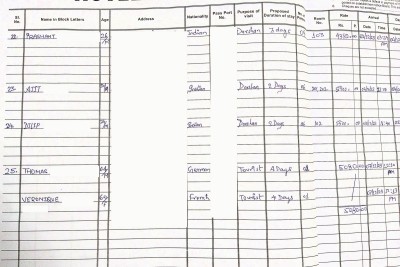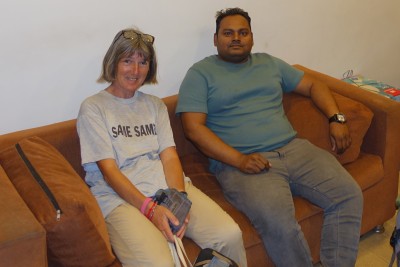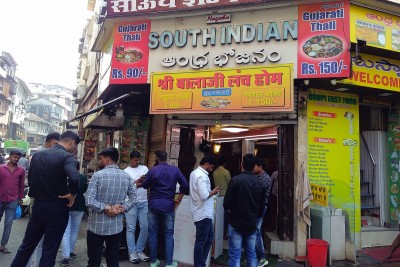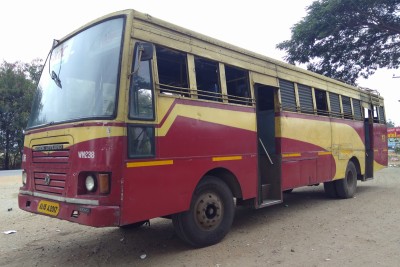Trip Report and Budget
(vero;2024-Feb-29)
We covered a lot of ground during this trip: we started in Delhi and ended in Mumbai, re-visiting some places we already knew quite well (Delhi, Agra, Varanasi, Mysuru and Mumbai) and discovering many new ones along the way.
You can retrace our route on this map showing our itinerary.
We were there for 56 days and managed on a budget of 1835 Rs (€20/£17) per day for the two of us. More than half of it was for accommodation (56.3%), then came local transport (22.4%), food (12.3%), fees (7.3%) and other assorted stuff (1.7%). This is much in line with what we spent at the beginning of the year during our SevenUp 2023 trip in the north eastern states.

- Hotels: all our rooms were with attached bathroom (except in Varanasi). The average daily price in the chart on the left is calculated on the basis of 48 nights from 56 as we used many night trains and one night bus to cover long distances.
- Food: many unlimited thalis, delicious kathi rolls and a few biryanis.
- Transport: we travelled a lot by train during this trip, it was an ideal and stress free way to move from one place to the other.
- Fees: read how we got really fed up with ASI, the Archeological Survey of India.…
- Miscellaneous: includes the cost of an Indian Airtel SIM
Hotels
During this trip, we dropped our bags in sixteen different rooms, all with attached bathroom (except in Varanasi); we used Booking.com to book nine of them, we found the rest on the ground. We encountered quite a few refusals (even booking.com cancellations) on the ground of many hotels not accepting foreigners.
- Puri was the only town where we had really a hard time finding something without booking ahead. With the triple attraction of the high revered Jagannath temple, a good beach and sea-side promenade and the Konark temple nearby, the place is completely swamped by Indian tourists. Most of them come by bus loads, others (like us) come by train. We met a couple one evening who had come to Puri for a stay of two days and one night; they came from Delhi which means they had spent 2 nights and a full day in the train to get there, and had to face the same to return to Delhi. Crazy. Finding a reasonable room in Puri was not easy because prices were high but foremost because nearly all of the hotels which we asked did not accept foreigners. If you ever come to Puri, your best bet is to follow the advice of your travel guide (Lonely Planet or Rough Guide): head to the eastern side of town, that's where most backpackers end-up and where a few hotels do accept them.…
- Mumbai was our most expensive overnight stop. We had no fixed date as of our arrival day in Mumbai and when searching online for a place (even two weeks before), we realised that the downtown prices (if at all available) were definitely not in our league. As we did not feel like roughing it up in the budget holes of Colaba (who are not online), we decided to try the western suburbs and booked a room in Andheri East for 2226 Rs (our only room with AC). It was definitely a good move. The location was convenient, in a quiet side street halfway between Asalpha and Sakinaka metro stations and going into downtown Mumbai was easy: a short walk to Asalpha station (10 min) to catch a metro to Ghatkopar, two stations away (10 Rs) and then switch to one of the very frequent trains heading to CSMT (10 Rs). A fast train takes about 30 min and the whole trip between 60 and 75 minutes.
- Madhuban with 600 Rs attached was our cheapest room. We were a bit worried as we arrived without any booking and not a clue as to what kind of accommodation we would find in this pilgrim town. It proved to be totally easy: our shared tuk-tuk dropped us at a corner and as we were looking around, a lady stepped out of a building and told us she had a room available if we were looking for one. We would not have guessed a hotel when in front of building, but it turned to be quite big, geared for pilgrim groups; everything was in Hindi and there was no sign (that we could read). It worked for us, although it was quite noisy with the many pilgrim groups arriving or leaving in the night or in the early hours.
See a summary of our hotels below:
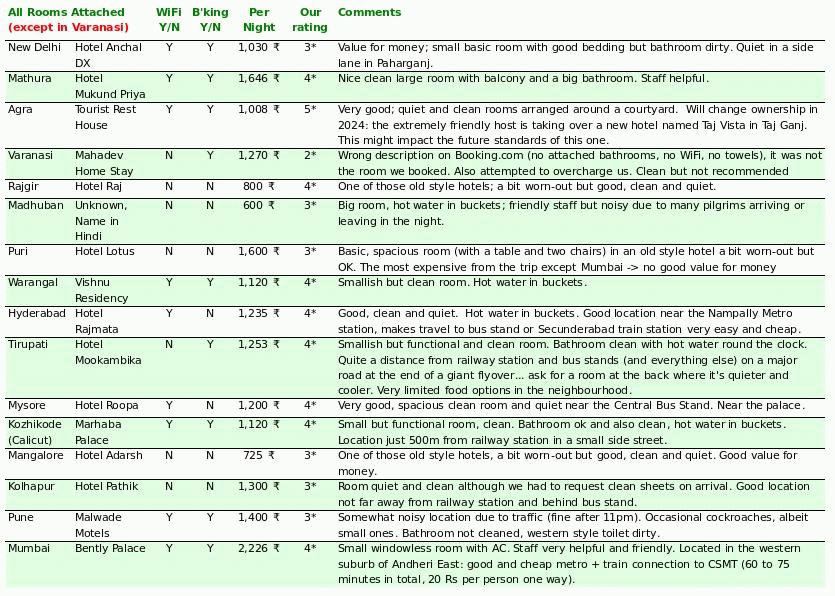
As usual, our diet is very simple… mostly vegetable thalis in the evening, bananas, snacks, biscuits or crackers during the day, the occasional Indian sweet before going to bed, purified water and if fizzy drink, local brand only. No alcohol. We have breakfast in our room, preparing our own tea and boiling water with a heating coil, munching some biscuits or crackers with it. Pricewise, a vegetable thali will typically cost anything between 70 and 120 Rs. We treated ourselves to a few Byrianis (200-300 Rs) and developed an addiction to Kathi Rolls which we had discovered in Kolkata in Spring.
We had our best thali of the whole trip in the restaurant pictured on the right which we found by chance in the Fort area of Mumbai. It is a tiny cramped place with only three tables each sitting four people, so guests have to queue outside. On offer are delicious thalis (and nothing else) with unlimited chapatis + rice for 90 Rs or a thali with four chapatis + rice for 70 Rs. There were two of us, so we had to wait a bit longer than the others so that we could sit together but otherwise people are ushered in as soon as a guest is finished. Plates are perfunctorily washed with a gush of water and you have to dry them yourself before getting served ;-)
A defining feature of this trip has been our extensive use of trains, a convenient and incredibly cheap way of travelling in India (it made up 58% of our transport budget, a real bargain considering the distance covered). We booked all our night trains (except one) online from home: places are few and travellers many, so one has to keep on the ball and move fast. The reservation window of Indian Rail opens 120 days before the date of travel, which means one has to have a fixed schedule, something which we usually do not like very much, but in this case, the distances to cover were such that we had no real choice. And it worked perfectly well. We tend to book 3AC nowadays: the carriages have the same layout as in sleeper class but they have the added bonus of a blanket, sheets and pillow, a bit more padding on the seat plus no unbooked passengers allowed inside. Among so many trips, we had only one bad train from Parasnath to Puri which was very dirty and home to many roaming cockroaches, but all others were OK.
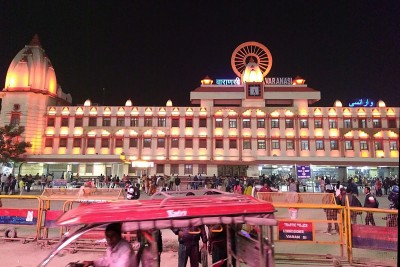 Because we did not know how long we would stay in Agra, we had not booked anything for the journey Agra-Varanasi. We were not so keen on the idea of taking an expensive night bus so we went to Agra station just in case something was available. And yes! we managed to book a night train at the counter, benefiting from the Foreign quota. The only drawback was that we had to catch the train at Tundla JN, some 30 km east of Agra, but this was no issue as there was even a local shuttle bus going there from the Fort bus terminal (Bus 35, 50 Rs per person, one and a half hour in the evening rush hour). This is something to think about in the future: check for alternatives at nearby railway junctions which see more traffic than the cities themselves. And as usual, check the website of the Man in Seat 61 for everything you need to know about train travel in India.
Because we did not know how long we would stay in Agra, we had not booked anything for the journey Agra-Varanasi. We were not so keen on the idea of taking an expensive night bus so we went to Agra station just in case something was available. And yes! we managed to book a night train at the counter, benefiting from the Foreign quota. The only drawback was that we had to catch the train at Tundla JN, some 30 km east of Agra, but this was no issue as there was even a local shuttle bus going there from the Fort bus terminal (Bus 35, 50 Rs per person, one and a half hour in the evening rush hour). This is something to think about in the future: check for alternatives at nearby railway junctions which see more traffic than the cities themselves. And as usual, check the website of the Man in Seat 61 for everything you need to know about train travel in India.
We even used trains for smaller deplacements during the day: we booked two to one days before in second sitting or sleeper to be sure to have a seat. A good point is that stations are often in the centre of towns, so easily accessible, not so good is that trains are not always punctual: we had one case of our train stopping without any apparent reason for 3/4 hour 10 km before our destination. We were fuming!
We took a night bus from Mangalore to Kolhapur: a sleeper for 1500 Rs per person which dropped us not far from the centre before continuing to Mumbai.
Fees
ASI, the Archeological Survey of India, is the body responsible for managing and maintaining historical sites across India, of which many can be visited free of charge. You can check their website for a list of their ticketed monuments sorted by state or a page dedicated to the World Heritage sites of India. For information, prices (as of Jan 2024) for foreigners are significantly higher than for Indian nationals (which is fair enough): as a rough guide the price of a "minor site" is 300 Rs while it is 600 Rs for major and World Heritage sites (Indians pay respectively 25 and 40 Rs).
However it is not all good with ASI and we have grown quite frustrated with them during this trip to the extent that we skipped some sites we would have visited otherwise towards the end of the trip just because they were managed by ASI. There are different reasons for this:
- The first one is that ASI have embraced cashless ticketing with online booking for a certain time slot. This is not a bad thing, so much more that thanks to the ubiquitous UPI system (Unified Payment Interface), Indians are used to pay cashless with their smartphone, even for small amounts when ordering tea or street food for example. But this means that if you are a foreigner, you have to be always online to be able to book once at the site or plan carefully your day ahead and book your slot before setting off. Plus, you have to trust the system and keep faith when entering your credit card details, something which always makes us a bit nervous. So it happened that we would arrive at a site and could not enter as there was no way to buy a ticket other than going online and paying with credit card. From experience, we can say that the major sites and the World Heritage sites like Agra Fort, Golconda, Konark or Nalanda still operate counters for customers paying cash; some other (minor) sites like Somnathpur or Jaunpur Fort are understanding and willing to help and their security personal will offer to book tickets with their smartphone against cash: once booked, all one has to do is take a picture of the generated QR code appearing on their phone and present it at the turnstile. But other sites like Sri Rangapatnam near Mysuru for example are merciless: rule is rule and in that case the security personal was completely dismissive, "ask your driver" was their answer. But what about independent tourists without a driver? In the end we did not visit and left highly frustrated. Something good to know when paying cash at an ASI site is that cash tickets are more expensive (mostly by a bearable 50 Rs) than online ones.
- Another disappointing point is that their sites have fallen victims to the explosion of inner Indian tourism: the sites are sometimes full to the brim and ASI has found no other way to manage the crowds than restricting access to parts of the sites or channelling the tourists. Access to the upper platform of some temples is forbidden, court yards are cordoned off, rooms are closed, others are only to be seen from the door. We could not help but sometimes feel cheated after having paid 600 Rs for a frustrating visit.
- Not to speak of sites such as Warangal Fort which are by no means worth the entry fee we paid: a loveless accumulation of stones and bits of architecture without any explanation or context. Many Indians were there for a picnic (kids under 15 go free), this is OK if you have paid 25 Rs to enjoy the park, a bit harsh when you have paid 300 Rs (although we had a good time sharing a picnic with some visitors).
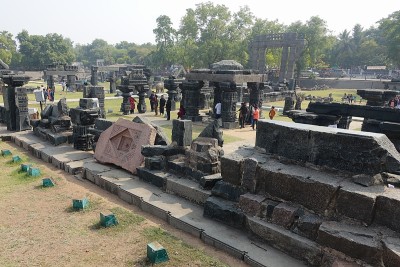 We believe that things will smooth over in the near future: most independent travellers (like us) use nowadays an Indian SIM so being always online is not so big an issue. Plus we have read that the UPI system has been extended to G-20 foreigners and NRIs (Non Resident Indians) so this would be a way to solve the credit card issue (Google Pay would also be an alternative). But it is something to be aware of for the time being and personally we resent one more added layer of logistics to deal with on arrival on top of the sourcing of the SIM card. Long are the times gone when travel was stress free and easy!
We believe that things will smooth over in the near future: most independent travellers (like us) use nowadays an Indian SIM so being always online is not so big an issue. Plus we have read that the UPI system has been extended to G-20 foreigners and NRIs (Non Resident Indians) so this would be a way to solve the credit card issue (Google Pay would also be an alternative). But it is something to be aware of for the time being and personally we resent one more added layer of logistics to deal with on arrival on top of the sourcing of the SIM card. Long are the times gone when travel was stress free and easy!
Miscellaneous
Not much to report here except for the purchase of an Airtel SIM on arrival at Delhi Airport. We were lucky when we arrived at their counter in the arrival hall (after having cleared customs) as we were immediately served (we passed the immigration controls speedily and our bag was one of the firsts to pop out), but ten minutes later the queue behind us was quite significant. We paid 450 Rs for a 28 days SIM which we topped up easily in Puri for further 28 days (240 Rs) at a mobile phone shop. We were told at the airport to wait a few hours and then call a certain number, quoting a code to get the number connected. This sounded really easy but turned out to be not so straight forward. We dutifully called the number again and again and always ended up in a queue going nowhere. We were near despair when we spotted an Airtel shop near Connaught Place where after two attempts a nice guy got us sorted.
Not sure how we would have fared without him, we would probably have asked our hotel staff for help.
Want to read more? Go on to Uttar Pradesh with a Difference or go up to Blog
$ updated from: Blog.htxt Mon 28 Apr 2025 14:55:27 trvl2 — Copyright © 2025 Vero and Thomas Lauer unless otherwise stated | All rights reserved $




